Magnetism MCQs
NEET Chemistry For Magnetism And Matter Multiple Choice Questions
Question 1. A short bar magnet of magnetic moment 0.4JT-1 is placed in a uniform magnetic field of 0.16 T. The magnet is in stable equilibrium when the potential energy is:
- – 0.64 J
- zero
- – 0.082 J
- -0.064 J
Answer: 4. -0.064 J
Given
A short bar magnet of magnetic moment 0.4JT-1 is placed in a uniform magnetic field of 0.16 T.
We know that, U=-M B \(\cos \theta\)
for stable equilibrium \(\theta=0^{\circ}\)
U =\(-M B \cos 0^{\circ}\)
= -M B=-(0.4)(0.16)
= -0.064 \(\mathrm{~J}\)
Question 2. A bar magnet is hung by a thin cotton thread in a uniform horizontal magnetic field and is in an equilibrium state. The energy required to rotate it by 60° is W. Now the torque required to keep the magnet in the new position is:
- \(\frac{W}{\sqrt{3}}\)
- \(\sqrt{3} W\)
- \(\frac{\sqrt{3} W}{2}\)
- \(\frac{2 W}{\sqrt{3}}\)
Answer: 2. \(\sqrt{3} W\)
Given
A bar magnet is hung by a thin cotton thread in a uniform horizontal magnetic field and is in an equilibrium state. The energy required to rotate it by 60° is W.
Since work was done by rotating the magnet,
W=M B\(\left(\cos \theta_0-\cos \theta\right)\)
Where, \(\mathrm{M}\)= magnetic moment of the magnet
B= magnetic field
W =M B\(\left(\cos 0^{\circ}-\cos 60^{\circ}\right) \)
=M B\(\left(1-\frac{1}{2}\right)=\frac{M B}{2}\)
M B =2 W → Equation 1
And Torque,\(\tau=M \times B=M B \sin 0^{\circ}\) putting M B=2 W from (1),
⇒ \(\tau =2 W \sin 60^{\circ}\)
=2 W \(\times \frac{\sqrt{3}}{2}=W \sqrt{3}\)
Read and Learn More NEET Physics MCQs
Magnetism MCQs
Question 3. The following figures show the arrangement of bar magnets in different configurations. Each magnet has a magnetic dipole moment of m. Which configuration has the highest net magnetic dipole moment
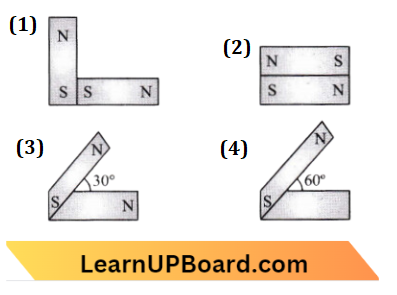
Answer: 3.
Given, that each magnet has a magnetic dipole moment =m.
Net magnetic moment =\(\sqrt{m^2+m^2+2 m^2 \cos \theta}\)
Here, if \(m_{\text {net }}\) is \(\max\) when \(\cos \phi\) is \(\max\) when \(\cos \phi\) will be \(\max\) when \(\theta\) in minimum.
So, \(\theta=30^{\circ} m_{\text {net }}\) will be maximum.
Magnetism Questions for NEET
Question 4. A bar magnet of length l and magnetic dipole moment M is bent in the form of an are as shown in the figure. The new magnetic dipole moment will be:
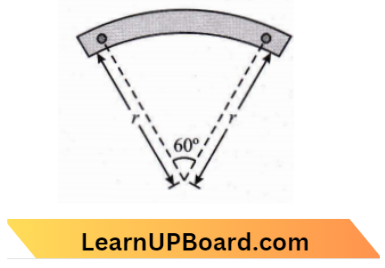
- M
- \(\frac{3}{\pi} M\)
- \(\frac{2}{\pi} M\)
- \(\frac{M}{2}\)
Answer: 2. \(\frac{3}{\pi} M\)
The magnetic pole strength is m then the magnetic moment, M=m l
From the given figure, l =\(\frac{3}{\pi} \times r\)
r =\(\frac{31}{\pi}\)
New magnetic moment, \(\mathrm{M}^{\prime} =m v r=m \times \frac{31}{\pi} \)
= \(\frac{3}{\pi} \times m l=\frac{3 M}{\pi}\)
Magnetism Questions for NEET
Question 5. A bar magnet of magnetic moment M is placed at right angles to a magnetic induction B. If a force F is experienced by each pole of the magnet. The length of the magnet will be:
- \(\frac{M B}{F}\)
- \(\frac{B F}{M}\)
- \(\frac{M F}{B}\)
- \(\frac{F}{M B}\)
Answer: 1. \(\frac{M B}{F}\)
Given
A bar magnet of magnetic moment M is placed at right angles to a magnetic induction B. If a force F is experienced by each pole of the magnet.
Here, \(\tau =\vec{M} \times \vec{B}\)
⇒ \(|\tau| =M B \sin 90^{\circ}\)
and we know that, \(\tau=F l\)
Fl =M B
l = \(\frac{M B}{F}\)
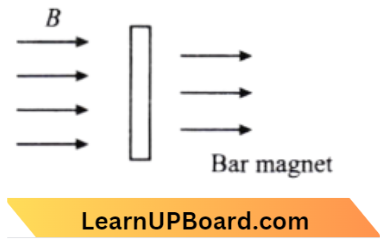
Question 6. Two identical bar magnets are fixed with their centers at a distance d apart. A stationary charge Q is placed at P in between the gap of the two magnets at a distance D from the center O as shown in the figure. The force on the charge Q is:
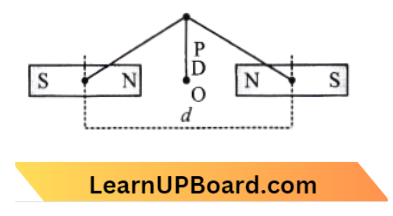
- zero
- directed along OP
- directed along PO
- directed perpendicular to the plane of the paper.
Answer: 1. zero
Given
Two identical bar magnets are fixed with their centers at a distance d apart. A stationary charge Q is placed at P in between the gap of the two magnets at a distance D from the center O as shown in the figure.
The force on charge Q is zero.
NEET Physics MCQs
Question 7. A bar magnet having a magnetic moment of 2 x 104 JT-1 is free to rotate in a horizontal plane. A horizontal magnetic field B = 6 x 104 T exists in the space. The work done in taking the magnet slowly from a direction parallel to the field to a direction 60° from the field is:
- 0.6 J
- 12 J
- 6 J
- 2 J
Answer: 3. 6 J
Given
A bar magnet having a magnetic moment of 2 x 104 JT-1 is free to rotate in a horizontal plane. A horizontal magnetic field B = 6 x 104 T exists in the space.
According to the question; When the magnetic dipole is rotated from the initial position \(\theta_1\) to the final position \(\theta_2\) then work is done.
= M B\(\left(\cos \theta_1-\cos \theta_2\right)\)
= M B\(\left(1-\frac{1}{2}\right)=\frac{2 \times 10^4 \times 6 \times 10^{-4}}{2}\)
= 6 \(\mathrm{~J}\)
Question 8. A bar magnet of magnetic moment M is placed in the magnetic field of induction B. The torque exerted on it is
- M. B
- -M. B
- M x B
- -M x B
Answer: 3. M x B
A magnetic torque \(\tau\) acts on a bar magnet when it is put in an external magnetic field B, which is given by,
∴ \(\tau=M \times B =[M] \times[B] \sin \theta (\theta\) = angle between M and B)
Class 12 Magnetism MCQs
Question 9. Does a bar magnet oscillate in the earth’s magnetic field with a period T. What happens to its period of motion if its mass quadrupled?
- Motion remains simple harmonic with new period \(\frac{T}{2}\)
- Motion remains simple harmonic with new period = 2T
- Motion remains simple harmonic with new period = 4T
- Motion remains simple harmonic and the period stays nearly constant.
Answer: 2. Motion remains simple harmonic with new period = 2T
We have, the time period of a bar magnet in a magnetic field,\(\mathrm{T}=2 \pi \sqrt{\left(\frac{\mathrm{I}}{M B}\right)}\)
Where I is the moment of inertia of the bar magnet, M is the magnetic moment and B is the magnetic induction.When mass is made 4 times (Since, I=\(m r^2, \mathrm{I} \propto m \)). From the above equation of period T \(\propto \sqrt{I}\). So, when mass is made 4 times, then T becomes twice.
Question 10. At point A on the earth’s surface the angle of dip \(\tan\) = + 25°. At a point B on the earth’s surface the angle of dip, \(\tan\) = – 25°. We can interpret that:
- A is located in the southern hemisphere.
- A is located in the northern hemisphere and B is located in the southern hemisphere.
- A and B are both located in the southern hemisphere.
- A and B are both located in the northern hemisphere.
Answer: 2. A is located in the northern hemisphere and B is located in the southern hemisphere.
Given
At point A on the earth’s surface the angle of dip \(\tan\) = + 25°. At a point B on the earth’s surface the angle of dip, \(\tan\) = – 25°.
The angle of dip is the angle between the earth’s resultant magnetic field from the horizontal. The dip is zero at the equator and positive in the northern hemisphere.
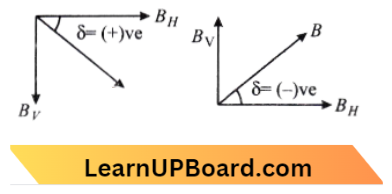
In the southern hemisphere dip angle is considered negative.
Class 12 Magnetism MCQs
Question 11. The relations amongst the three elements of earth’s magnetic field, namely horizontal component H, vertical component V, and dip \(\tan\) are, (\(B_E\) = total magnetic field):
- V=\(B_E \tan \delta, H=B_E\)
- V=\(B_E \sin \delta, H=B_E \cos \delta\)
- V=\(B_E \cos \delta, H=B_E \sin \delta\)
- V=\(B_{E^{\prime}} H=B_E \tan \delta\)
Answer: 2. V=\(B_E \sin \delta, H=B_E \cos \delta\)
Here \(B_E\)= net magnetic field and H and V are the horizontal and vertical components of \(B_E\).
⇒ \(\delta \) is the angle between \(\mathrm{B}_{\mathrm{E}}\) and \(\mathrm{H}\).
From figure we have, H =\(B_E \cos \delta \)
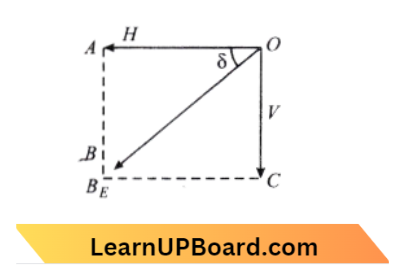
V =\(B_E \sin \delta \)
H =\(B_E \cos \delta\)
Concept in \(\triangle\) A O B, \(\cos \delta=\frac{H}{B_E}\)
⇒ \(\mathrm{H}=B_E \cos S\)
And, in\( \triangle \mathrm{OBC}\),
⇒ \(\sin \delta =\frac{V}{B_E}\)
V =\(B_E \sin \delta\) .
Important MCQs On Magnetism For NEET
Question 12. If \(\theta_1\) and \(\theta_2\) are the apparent angles of dip observed in two vertical planes at right angles to each other, then the true angle of dip is given by:
- \(\cot ^2 \theta=\cot ^2 \theta_1+\cot ^2 \theta_2\)
- \(\tan ^2 \theta=\tan ^2 \theta_1+\tan ^2 \theta_2\)
- \(\cot ^2 \theta=\cot ^2 \theta_1-\cot ^2 \theta_2\)
- \(\tan ^2 \theta=\tan ^2 \theta_1+\tan ^2 \theta_2\)
Answer: 1. \(\cot ^2 \theta=\cot ^2 \theta_1+\cot ^2 \theta_2\)
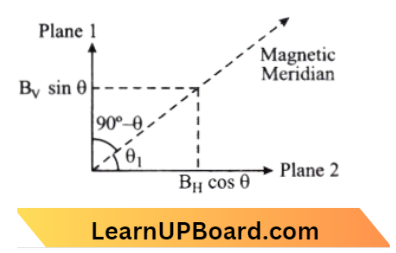
⇒ \(B_H\) and \(B_V\) be the Horizontal and vertical component of magnetic field B
⇒ \(\tan \theta =\frac{B_V}{B_H}\)
⇒ \(\cot \theta=\frac{B_H}{B_V}\) → Equation 1
Again we have,\( B_1 =B_H \cos \theta^{\prime} \)
⇒ \(B_2 =B_H \sin \theta^{\prime}\)
⇒ \(\tan \theta_1 =\frac{B_V}{B^{\prime}}=\frac{B_V}{B_H \cos \theta^{\prime}} \)
⇒ \(\cot \theta_1 =\frac{B_H \cos \theta^{\prime}}{B_V}\)
Similarly, \(\tan \theta_2=\frac{B_V}{B_H} and \quad \cot \theta_2=\frac{B_H \sin \theta^{\prime}}{B_V}\) → Equation 2
From eq. (1) and (2)
⇒ \(\cot ^2 \theta_1+\cot ^2 \theta_2=\frac{B_H^2 \cos ^2 \theta^{\prime}}{B_V^2}+\frac{B_H^2 \sin ^2 \theta^{\prime}}{B_V^2}\)
∴ \(\cot ^2 \theta_1+\cot ^2 \theta_2=\cot ^2 \theta\)
Question 13. A compass needle which is allowed to move in a horizontal plane is taken to a geomagnetic pole. It:
- will become rigid showing no movement
- will stay in any position
- will stay in North-South direction only
- will stay in the East-West direction only.
Answer: 2. Will stay in any position
A compass needle when allowed to move in a horizontal plane is taken to a geomagnetic pole. It will stay in any position at the geomagnetic north and south pole.
Important MCQs On Magnetism For NEET
Question 14. A vibration magnetometer placed in a magnetic meridian has a small bar magnet. The magnet executes oscillations with a period of 2s in Earth’s horizontal magnetic field at 24 μ. When a horizon
tal field at 18 μ is produced opposite to the earth’s field by placing a current-carrying wire, the new time period of the magnet will be:
- 1s
- 2s
- 3s
- 4s
Answer: 2. 2s
Given
A vibration magnetometer placed in a magnetic meridian has a small bar magnet. The magnet executes oscillations with a period of 2s in Earth’s horizontal magnetic field at 24 μ. When a horizontal field at 18 μ is produced opposite to the earth’s field by placing a current-carrying wire
Period of vibrating magneto-meter is,
⇒ \(\mathrm{T} =2 \pi \sqrt{\frac{I}{M \times B_H}} \)
T \(\propto \sqrt{\frac{1}{B_H}} \)
⇒ \(\frac{T_1}{T_2} =\sqrt{\frac{\left(B_H\right)_1}{\left(B_H\right)_2}} \)
⇒ \(\frac{2}{T_2} =\sqrt{\frac{18}{24}} \)
T =2.35=2 \(\mathrm{~s}\)
Question 15. Due to the earth’s magnetic field, charged cosmic ray particles:
- can never reach the poles
- can never reach the equator
- require less kinetic energy to reach the equator than the poles
- require greater kinetic energy to reach the equator than the poles.
Answer: 4. require greater kinetic energy to reach the equator than the poles.
Since the earth’s magnetic field is stronger near the poles, so, charged particles of cosmic rays are deflected away from the equator.
Since, F = B.qv and K.E \(\propto\) v, they must have a higher K.E in order to reach the equator.
NEET Magnetism and Matter Questions
Question 16. An iron rod of susceptibility 599 is subjected to a magnetizing field of 1200 A \(\mathrm{m}^{-1}\). The permeability of the material of the rod is (Take, \(\mu_0=4 \pi \times 10^{-7} \mathrm{~T} \mathrm{~mA}^{-1}\)):
- \(80 \times 10^{-5} \mathrm{~T} \mathrm{~mA}^{-1}\)
- \(2.4 \pi \times 10^{-5} \mathrm{~T} \mathrm{~mA}^{-1}\)
- \(2.4 \pi \times 10^{-7} \mathrm{~T} \mathrm{~mA}^{-1}\)
- \(2.4 \pi \times 10^{-4} \mathrm{~T} \mathrm{~mA}^{-1}\)
Answer: 4. \(2.4 \pi \times 10^{-4} \mathrm{~T} \mathrm{~mA}^{-1}\)
Given, \(\chi\)=599
Magnetic field, B=1200 \(\mathrm{Am}^{-1}\)
Permeability of the material of the rod,
⇒ \(\mu_m =\mu_0(1+\chi)\)
= 4 \(\pi \times 10^{-7}(1+599) \)
= 2.4 \(\pi \times 10^{-4} \mathrm{Tm} \mathrm{A}^{-1}\)
Question 17. The magnetic moment of a diamagnetic atom is:
- much greater than one
- one
- between zero and one
- equal to zero
Answer: 4. equal to zero
The magnetic moment of a diamagnetic atom is Related Theory equal to zero
Physics MCQs For NEET With Answer
Question 18. A thin diamagnetic rod is placed vertically between the poles of an electromagnet. When the current in the electromagnet is switched on, then the diamagnetic rod is pushed up, out of the horizontal magnetic field. Hence, the rod gains gravitational potential energy. The work required to do this comes from:
- the lattice structure of the material of the rod
- the magnetic field
- the current source
- the induced electric field due to the changing field.
Answer: 3. the current source
Given
A thin diamagnetic rod is placed vertically between the poles of an electromagnet. When the current in the electromagnet is switched on, then the diamagnetic rod is pushed up, out of the horizontal magnetic field. Hence, the rod gains gravitational potential energy.
The energy of the current source will be converted into the potential energy of the rod.
Question 19. The magnetic susceptibility is negative for:
- paramagnetic material only
- ferromagnetic material only
- paramagnetic and ferromagnetic materials
- diamagnetic material only.
Answer: 4. diamagnetic material only.
Magnetic susceptibility = \(\chi\)
It is negative for diamagnetic material only
Question 20. There are four lightweight rod samples A, B, C, and D respectively suspended by threads. A bar magnet is slowly brought near each sample and the following observations are noted:
(1) A is freely repelled
(2) B is freely attracted
(3) C is strongly attracted
(4) D remains unaffected
Which one of the following is true?
- C is of diamagnetic material
- D is of a ferromagnetic material
- A is of non-magnetic material
- B is of a paramagnetic material
Answer: 4. B is of a paramagnetic material
(1) Paramagnetic material will be freely attracted,
(2) Diamagnetic material will be freely repelled,
(3) Ferromagnetic material will be strongly attracted
Physics MCQs For NEET With Answers
Question 21. If a diamagnetic substance is brought near the north or the south pole of a bar magnet, it is:
- repelled by both the poles
- repelled by the North Pole and attracted by the South Pole
- attracted by the North Pole and repelled by the South Pole
- attracted by both poles.
Answer: 1. repelled by both the poles
If a diamagnetic substance is brought near the north or the south pole of a bar magnet, it is repelled by both poles.
Question 22. Curie temperatures are the temperature above which:
- ferromagnetic material becomes paramagnetic material
- paramagnetic material becomes diamagnetic material
- paramagnetic material becomes ferromagnetic material
- ferromagnetic material become diamagnetic material
Answer: 1. ferromagnetic material becomes paramagnetic material
Curie temperature is that temperature above which a ferromagnet becomes paramagnet
Chapter-Wise MCQs For NEET Physics
Question 23. Nickel shows ferromagnetic properties at room temperature. If the temperature is increased beyond Curie’s temperature, then it will show:
- anti ferromagnetism
- no magnetic property
- diamagnetism
- paramagnetism.
Answer: 4. paramagnetism.
Above curie’s temperature, ferromagnetic material behaves as paramagnetic material.
Question 24. If the magnetic dipole of an atom of diamagnetic material, and paramagnetic material are denoted by \(\mu_d, \mu_p,\mu_f\) respectively, then:
- \(\mu_d=0 and \mu_p \neq 0\)
- \(\mu_d \neq 0 and \mu_p=0\)
- \(\mu_p=0 and \mu_f \neq 0\)
- \(\mu_d \neq 0 and \mu_f \neq 0\).
Answer: 1. \(\mu_d=0 and \mu_p \neq 0\)
∴ \(\mu_{\mathrm{P}} \neq \mu_f \neq 0 \text { and } \mu_d\)=0
Question 25. A diamagnetic material in a magnetic field moves:
- from stronger to the weaker parts of the field
- from weaker to the stronger parts of the field
- perpendicular to the field
- in none of the above directions
Answer: 1. from the stronger to the weaker parts of the field
A diamagnetic material in a magnetic field moves from the stronger to the weaker part of the field.
Question 26. According to Curie’s law, the magnetic susceptibility of a substance at an absolute temperature T is proportional to:
- \(\frac{1}{T}\)
- T
- \(\frac{1}{T^2}\)
- \(T^2\)
Answer: 1. \(\frac{1}{T}\)
From Curie Law,\(\chi_m \propto \frac{1}{T}\)
Chapter-Wise MCQs For NEET Physics
Question 27. In which type of material the magnetic susceptibility does not depend on temperature?
- Diamagnetic
- paramagnetic
- Ferromagnetic
- Ferrite
Answer: 1. Diamagnetic
Material’s magnetic susceptibility is a measurement of how easily a specimen of that material may be magnetized in a magnetic field. Magnetic susceptibility \((\chi_m)\) of a diamagnetic substance is temperature independent.
Question 28. For protecting sensitive equipment from the external magnetic field, it should be:
- placed inside an aluminum can
- placed inside an iron can
- wrapped with insulation around it when passing a current through it
- surrounded with fine copper sheets.
Answer: 2. placed inside an iron can
Iron is a ferromagnetic substance. Since ferromagnetic substances have no magnetic lines of force. Hence, equipment can be protected by placing it within a ferromagnetic substance container. As a result, it’s kept in an iron can.
Magnetic Field And Lines MCQs
Question 29. A diamagnetic substance is brought near a strong magnet, then it is:
- attracted by a magnet
- repelled by a magnet
- repelled by North pie and attracted by South pole
- attracted by the North Pole and repelled by the South Pole.
Answer: 2. repelled by a magnet
When diamagnetic substances are placed in the magnetic field of a powerful magnet, they are either weakly magnetized in the opposite direction of the field or repelled by the powerful magnet.
